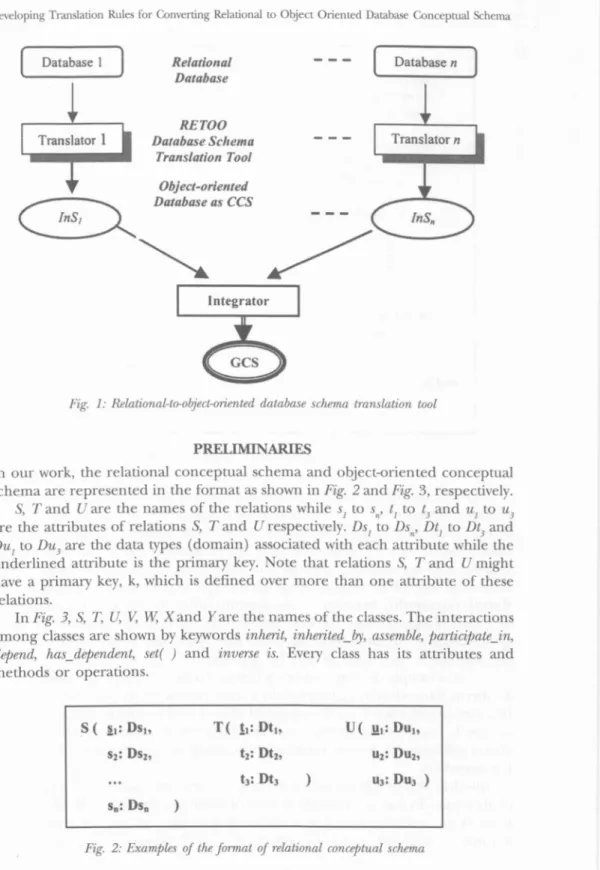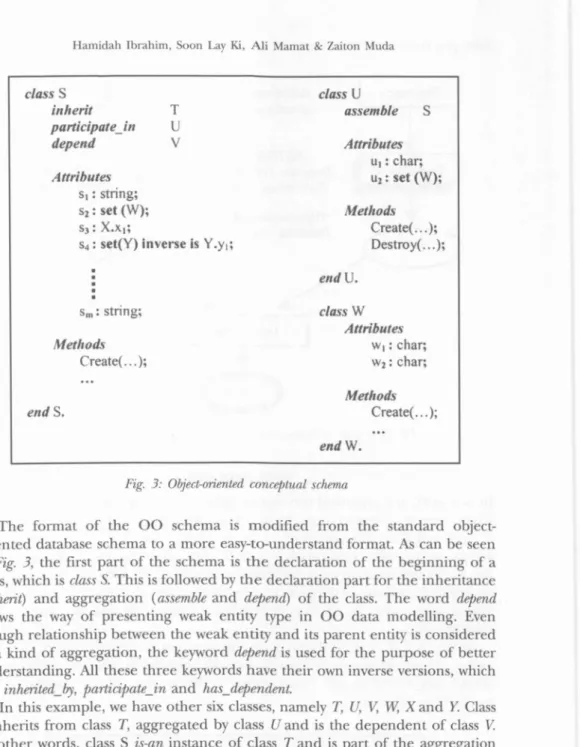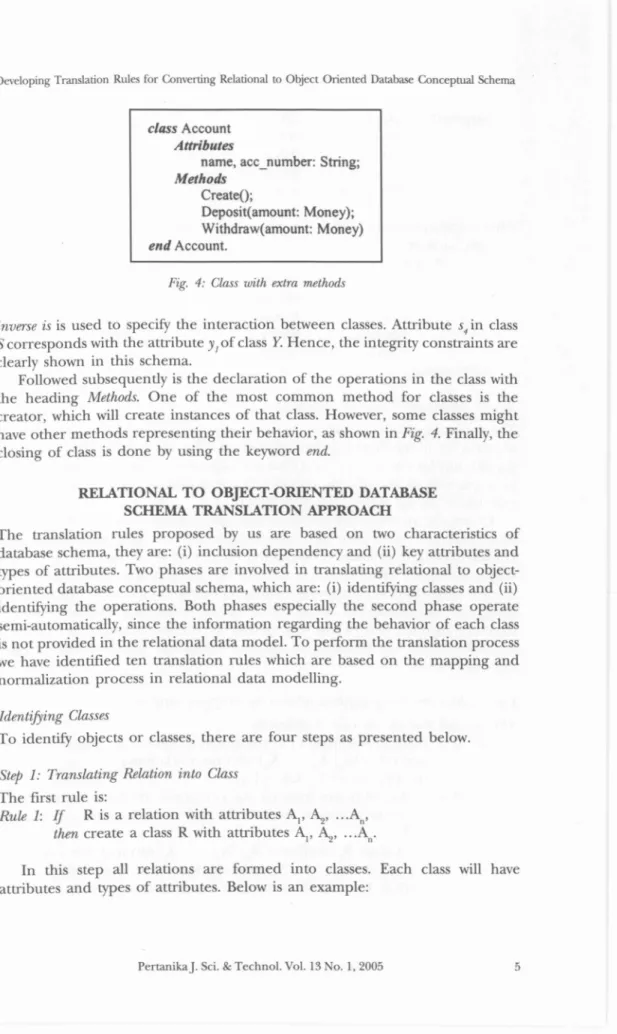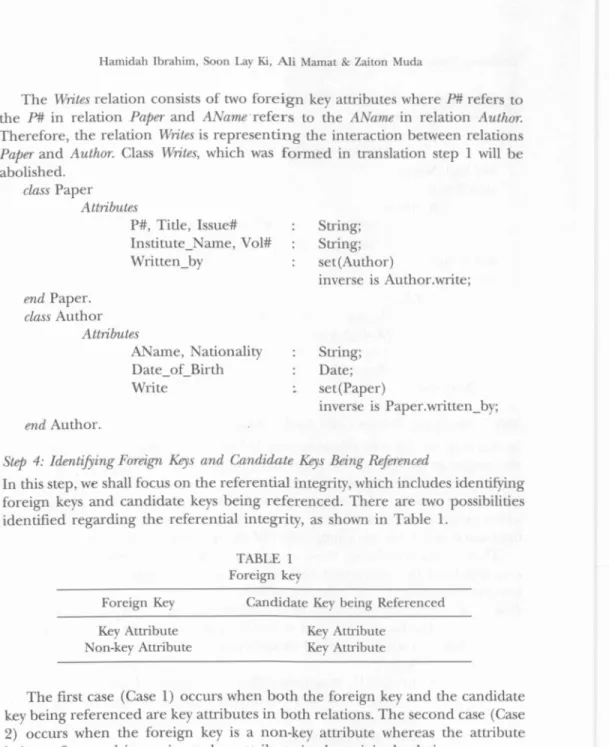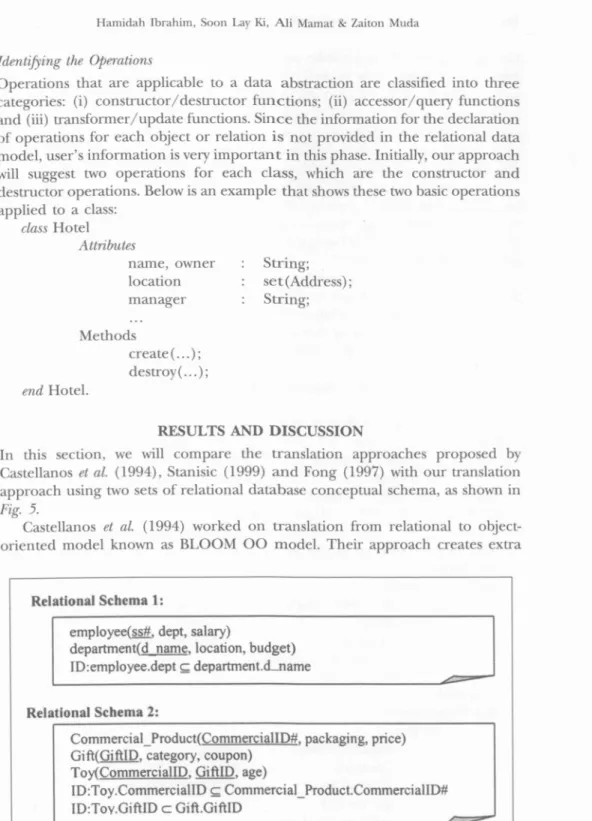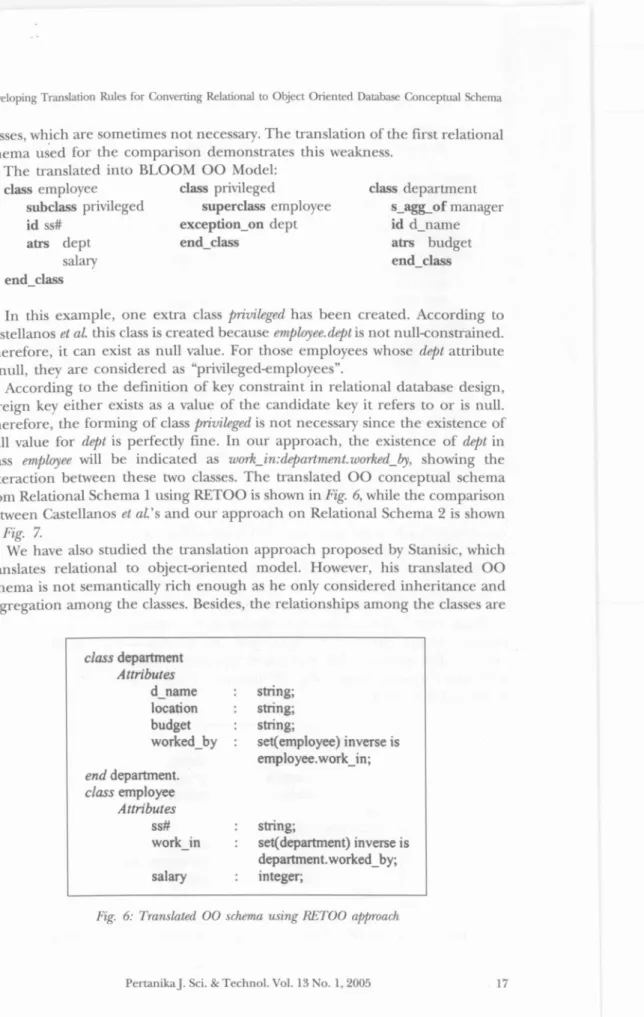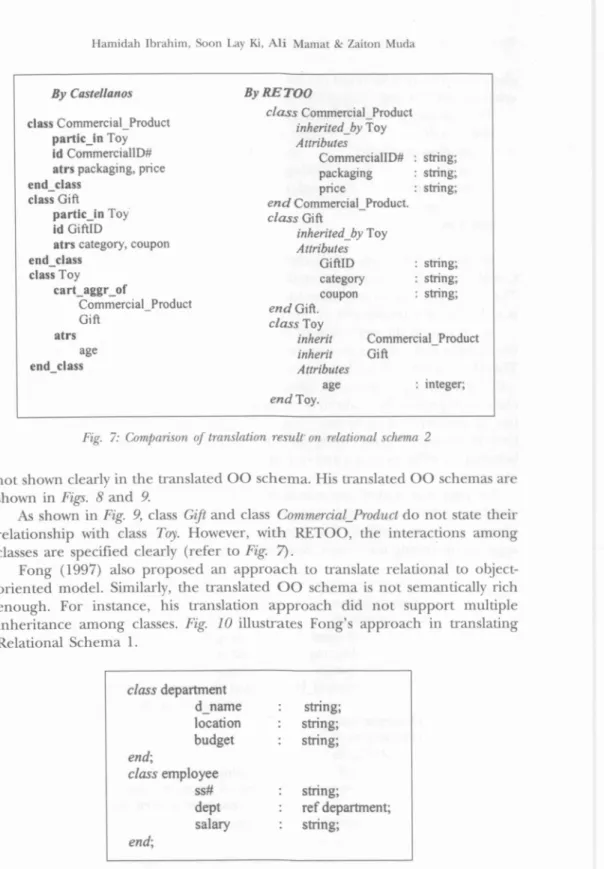PertanikaJ. Sci.&Techno!. 13(1): I - 21 (2005)
ISSN: 0128-7680 © Universiti Putra Malaysia Press
Developing Translation Rules for Converting Relational
to Object Oriented Database Conceptual Schema
Hamidah Ibrahim, SoonLayKi, Ali Mamat & Zaiton MudaDepartment of Computer Science
Faculty of Computer Science and Information Technology Universiti Putra Malaysia
43400 UPM, Serdang, Selangor, Malaysia E-mail: hamidah@fsktm.upm.edu.my
Received: 27 November 2001
ABSTRAK
Pangkalan data multi adalah satu persekutuan sistem pangkafan data teragih, heterogen dan berotonomi yang telah ujud. Kebiasaannya, proses integrasi adalah perlu dalam usaha membentuk satu sistem pangkalan data teragih yang heterogen. Proses ini secara amnya mengandungi dua fasa utama, iaitu fasa penterjemahan skema konseptual diikuti dengan fasa integrasi. Makalah ini mempersembahkan satu pendekatan penterjemahan untuk menukar skema pangkalan data hubungan kepada skema pangkalan data berorientasi objek. Pendekatan penterjemahan tersebut mengandungi satu set peraturan penterjemahan, yang berdasarkan kepada kebergantungan terangkum, atribut kunci dan jenis atribut. Satu prototaip alat penterjemahan skema pangkalan data, dipanggil RETOO dibangunkan berdasarkan kepada pendekatan penterjemahan yang dicadangkan. RETOO menerima skema pangkalan data hubungan sebagai data input dan menjana skema pangkalan data berorientasi objek sebagai output. Pendekatan penterjemahan bukan sahaja dapat memelihara semantik skema pangkalan data hubungan tersebut, tetapi juga meningkatkan semantik skema berorientasi objek yang diterjemahkan melalui konse(f permodelan data berorientasi objek.
ABSTRACT
A multidatabase is a confederation of pre-existing distributed, heterogeneous, and autonomous database system. Obviously, the integration process is essential in the effort of forming a distributed, heterogeneous database system. This process generally consists of two main phases, which are conceptual schema translation phase followed by the integration phase. This paper presents a translation approach to convert relational database schema to object-oriented database schema. The translation approach consists of a set of translation rules, which is based on inclusion dependencies, key attributes and types of attributes. A database schema translation tool prototype, called RETOO (RElational-To-Object-Qriented) is then developed based on the proposed translation approach. RETOO receives a relational database schema as input data and generates an object-oriented database schema as the output. The translation approach is not only able to maintain the semantics of the relational database schema, but also enhance the semantics of the translated oriented schema via object-oriented data modeling concepts.
INTRODUCTION
In today's information age, databases and database technology are having a major impact on the growing use of computers. The government, education, medicine, engineering, business and other areas have computerized all or part of their daily functions. Undoubtedly, these computerization processes often include database systems to model and store the information of the real-world entities involved in these functions. The computing environment in most of these contemporary organizations contains distributed, heterogeneous, and autonomous hardware and software systems. Therefore, there is an increasing need to support the co-operations of the services provided by these different software and hardware.
The existence of multiple, heterogeneous and autonomous databases within an organization means the globally important information exists in separate local database management systems (DBMSs), thus making the existing data inaccessible to remote users. One solution is to integrate these databases to form a single cohesive definition of a multi-database. Most of the integration is made possible with the support of database translation, which is the task of translation from one database conceptual schema into another.
Most works on schema translation deal with conversion from the entity-relationship (ER) model to the relational model or some extension of it (Castellanos et al. 1994; Castellanos and Saltor 1991). There are many works on translation from ER model into relational model or vice versa (Huang et al. 1997; Lukovic and Mogin 1996; SeoI1997). Besides, works on general frameworks for schema translation were also carried out (McBrien and Poulovassilis 1998). evertheless, only a few works have been done on translating relational schema into object-oriented (00) schema (Castellanos et al. 1994; Castellanos and Saltor 1991; Fong 1997; Soon et al. 2001; Stanisic 1999). Stanisic (1999) focused his work not only on schema translation, but query translation as well. While Castellanos et al. (1994) proposed a methodology to translate the relational model into Barcelona Object-Oriented Model, namely BLOOM model. However, these works have their limitations respectively, especially in terms of translated 00 model representation. The limitations in the BLOOM 00 model include (i) the syntax of resulted BLOOM00model is not easy to understand, such as the keywords s_aggre~ofand compl~eneraliz_of;(ii) the model tends to create extra classes, which are sometimes not necessary; and
(iii) the data types of attributes in BLOOM 00 model are not specified. In our work, a set of translation rules is proposed to translate relational database conceptual schema into 00 database conceptual schema. This set of translation rules is applied in a database schema translation tool prototype, called RETOO (RElational-To-Object-Oriented), with the assumption that 00
conceptual schema is used as the canonical conceptual schema (CCS). This canonical conceptual schema will then be integrated into the global conceptual schema (GCS) of the distributed, heterogeneous database system. Fig. 1 briefly illustrates the system. InS] ... InSn shown inFig. 1 are intermediate schemas or known as canonical conceptual schemas.
Developing Translation Rules for Converting Relational to Object Oriented Database Conceptual Schema Databasen ) Relational Database RETOO Database Schema Translation Tool Database 1 Object-oriented
C
InSJ~
Database as CCS~/
Fig. 1: Relational-to-object-onented database schema translation tool
PRELIMINARIES
In our work, the relational conceptual schema and object-oriented conceptual schema are represented in the format as shown inFig. 2 andFig.3, respectively. S, Tand Uare the names of the relations while sJ to sn' tJto t;and u Jto u; are the attributes of relations S, Tand Urespectively. DSJto Dsn, Dt/to Dt;and Du/toDu;are the data types (domain) associated with each attribute while the underlined attribute is the primary key. Note that relations S, T and Umight have a primary key, k, which is defined over more than one attribute of these relations.
InFig. 3,S, T, U, V,
vv,
X and Yarethe names of the classes. The interactions among classes are shown by keywords inherit, inherited_lJy, assemble, participate_in,depend, has_dependent, set( ) and inverse is. Every class has its attributes and
methods or operations.
T( 11: Dth t1: Dt1, tJ: DtJ
Fig. 2:Examples oj the Jormat oj relational conceptual schema
class S inherit T participate_ill U depend V Attributes Sl : string; S2:set (W); S3: X,XI;
S4:set(y) Inverse IsY'YI;
sm: string; Methods Create( ... ); endS. classU assemble S Attributes u.: char; Uz:set(W); Methods Create( ); Destroy( ); endU. classW Attributes WI:char; W2:char; Methods Create( ... ); endW.
Fig. 3: Object-oriented conceptual schema
The format of the 00 schema is modified from the standard object-oriented database schema to a more easy-to-understand format. As can be seen in Fig. 3, the first part of the schema is the declaration of the beginning of a class, which is classS.This is followed by the declaration part for the inheritance
(inherit) and aggregation (assemble and depend) of the class. The word depend
shows the way of presenting weak entity type in 00 data modelling. Even though relationship between the weak entity and its parent entity is considered as a kind of aggregation, the keyword depend is used for the purpose of better understanding. All these three keywords have their own inverse versions, which
are inherited_fry, participate_inand has_dependent.
In this example, we have other six classes, namelyT, U, V,
vv,
X and Y. Class S inherits from class T, aggregated by class Uand is the dependent of class V.In other words, class S is-aninstance of class T and is part of the aggregation of class U. ClassVis the parent entity of weak entity S. In contrast, these inverse classes will have the inverse versions of the keywords, for example in class U, it
has assembleS.
Another keyword in the schema, i.e. setis used when attribute's type is a set of attributes. InFig. 3, S2consists of a set of attributes from class W otice that
there is an attribute, which is S3 with the data type of X.x
I' this means the
attribute is 'mapped' from attribute XI of class X. Besides these, the keyword
4 PertanikaJ. Sci.&Techno!. Vol. 13 o. 1,2005
Developing Translation Rules for Converting Relational to Object Oriented Database Conceptual Schema class Account
Attributes
name, acc_number: String;
Methods
CreateO;
Deposit(amount: Money); Withdraw(amount: Money)
end Account.
Fig. 4: Class with extra methods
inverse isis used to specify the interaction between classes. Attribute S4in class
S corresponds with the attributey10fclass Y. Hence, the integrity constraints are clearly shown in this schema.
Followed subsequently is the declaration of the operations in the class with the heading Methods. One of the most common method for classes is the creator, which will create instances of that class. However, some classes might have other methods representing their behavior, as shown in Fig. 4. Finally, the closing of class is done by using the keyword end.
RELATIONAL TO OBJECT-ORIENTED DATABASE SCHEMA TRANSLATION APPROACH
The translation rules proposed by us are based on two characteristics of database schema, they are: (i) inclusion dependency and (ii) key attributes and types of attributes. Two phases are involved in translating relational to object-oriented database conceptual schema, which are: (i) identifying classes and (ii) identifying the operations. Both phases especially the second phase operate semi-automatically, since the information regarding the behavior of each class is not provided in the relational data model. To perform the translation process we have identified ten translation rules which are based on the mapping and normalization process in relational data modelling.
Identifjing Classes
To identify objects or classes, there are four steps as presented below.
Step 1: Translating Relation into Class
The first rule is:
Rule 1:
If
R is a relation with attributes~, ~, An, thencreate a class R with attributes ~, ~, An•In this step all relations are formed into classes. Each class will have attributes and types of attributes. Below is an example:
Surgeon ( Same Street City Country Phone- 0 String, String, String, String, String String; String; String; String; String;
Mter translation from Step 1, we have class Surgeonas shown below:
classSurgeon Attrilnttes SName Street City Country Phone- 0 endSurgeon.
Step 2: IdentifYing Composite Attrilnttes
The general guideline to decide what an object is and what an attribute of an object is lies in the theory of data abstraction. This theory states that something should only be represented by a classifit represents a set of similar objects or concepts with meaningful properties and operations, which are required to be maintained by the system (Hughes 1991).
Composite attributes are attributes that can be divided into smaller subparts, which represent more basic attributes with independent meanings of their own (Elmasri 2003). Composite attributes represent a set of objects with meaningful simple attributes. There are three cases to be considered, namely: relation that consists ofmcomposite attributes with (i) no overlapping attribute between the composite attributes; (ii) at least two of the composite attributes have a common attribute and (iii) at least one of the composite attribute consists of attributes which are common to another composite attribute. Each case is discussed below.
Case 1:No overlapping attrilntte between the composite attrilnttes. The second translation rule is stated as:
Rule 2:
If
relation R consists of m composite attributes ~,where 1~i~m and ~={Ail'A2' ...,An}
with no overlapping attributes between the ~, i.e. n mi•1 ~ = { },
then - the attributes forming the composite attribute ~ are taken out from class R, and are formed as a newly defined class, say Tj;
- in class R, attributes
AI' A2' ..., An
forming the composite attribute ~ are replaced by statement RCAr' set(T), where R~ is an attribute in class R referring to class Tj•Developing Translation Rules for Converting Relational to Object Oriented Database Conceptual &hema
Referring to the example in Step 1, there is a composite attribute Address,
which consists of three attributes, namely: Street, City, and Country. As a result, these three attributes are taken out from the class Surgeon and formed as another class Address, as shown below:
classAddress
Attributes
Street, City, Country String;
endAddress. class Surgeon Attributes Same SAddress Phone-No endSurgeon. String; set(Address) ; String; String, String, String, String, String In 0 FName MInit Lame Phone- 0
If there exists the same non-key composite attributes in another relation, redundancies can be solved by referring to the same new class formed.
To illustrate cases 2 and 3, let say we have a relation with attributes as follows:
Surgeon (
Case2: At least two of the composite attributes have a common attribute.
The third translation rule is stated as:
Rule3:
If
relation R consists of a composite attribute~with attributes{AI'
A2, ••• , A } and another composite attribute CA with attributes
I In J
{AI' A2, ••• , A }, and there exists at least an attribute in CA, say
J J Jrn J
A
k, which exists in both CA and CA,!
J 1 J
then - the attributes forming ~ are taken out from class R and
formed as a newly defined class, say Tj;
the attributes forming CA are also taken out from class R and
J
formed as another newly defined class, say T.;
J
- in class Tj, attribute ~k is defined as A
j.: Tj"Aj.;
in class R, attributes
AI'
Ai2, ••• ,An
are replaced by statementRCA,: set(T), representing composite attribute ~;
- similarly, statementRCAi set(T)is used to replace attributesAI'
~2'
••. ,~rn'
representing composite attribute~.
JAndifthere is an attribute in CA.,sayAIwhich is a simple attribute by itself, then in classT.,
attribute ~,is defined as AiRA;Janda~tribute ~Iwill remain in class R. J PertanikaJ. Sci.&Techno!. Vo!. 13 No.1, 2005 7
Let's assume that there are two composite attributes in this relation, which are:
• arne: • Staff_ 0:
F arne, MInit, LName FNarne, Phone- 0
In this case, we have an attribute FName that exists in both composite attributesNameandStaff_No.The attributes that form these composite attributes will be taken out from the original relation and formed as classes, same as the simpler case discussed earlier. Therefore, after the translation process, we will get the following three classes:
className
Attributes
FName, MInit, LName String;
endName. class Staff_No Attributes FNarne Phone-No endStaff_No. class Surgeon Attributes ID_ 0 S arne Staff_ 0 endSurgeon. Name.FName; String; String; set(Name); set(StafC 0);
Case3: At least one of the composite attributes consists of attributes which are common
to another composite attribute.
The fourth translation rule is stated as:
Rule 4: IF relation R has a composite attribute CA = {AI' A2, ••• , A }and
'j I I I In
another composite attribute CA = {AI' A2, ••• , A }where CA C
J J J Jm J
CA (CA is a subset of CA),
I J I
then - the attributes~1' ~2' ••• , ~n forming
G\
are taken out fromclass R and formed as a newly defined class, say Tj;
- the attributes AI' A2, .•• , A forming CA are also taken out
J ~<. Jm J
and formed as another newly defined class, say Tj;
- in class Tj' attr~bute ~kwhere 1~k~m is defined as AjI': TCAjk;
- in class R, attnbutes ~l' ~2' ••• , ~n are replaced by statement
RCAj: set(T) representing composite attribute
G\;
- in class R, statementRCA/ set(T)is used to represent composite attribute CA.
J
In this case, let's assume that we have another two sets of composite attributes in the sarne relation Surgeon.
• Full_ arne: FNarne, Mlnit, L arne • arne: F arne, L arne
Full_Name.FNarne; Full_ arne.L arne;
Developing Translation Rules for Converting Relational to Object Oriented Database Conceptual Schema
Applying rule 4 will derive the following three classes:
class Full_ arne
Attributes
FNarne, MInit, L arne String;
endFull_Name. class arne Attributes FName LNarne end Name. class Surgeon Attributes ID_No SFull_Narne : SNarne Phone- 0 end Surgeon. String;
set (Full_ arne); set(Name); String;
Step 3: Identifying Relations with Foreign Keys only
In this step, we identify relations, which have only foreign keys. According to the mapping process in relational data modelling, a relation will have only foreign key attributes when the relation is formed as a result of an interaction between or among other relations in M:N relationship. These foreign keys, which originated from the key attributes of the relations involved in that interaction will form the primary key of this newly formed relation.
Thus, when translating these relations, we will regard them as an object resulting from the interaction between or arnong the classes that the foreign key attributes refer to, as reflected in Rule 5:
Rule 5:
If
relation R consists of n attributesA"
~,...,
An where eachA.
is the foreign key that refers to relations Ui, where 1$; i$; n,then - class R is treated as interactions of all the classes {UI' U2, ••• ,
Un}; - in classU
i, statements{R-set(U) inverse is UrR, R'set(UJ inverse
is U2.R, ... ,R- set(U,) inverse is Un.R} - {R-set(U) inverse is ~.R)
are stated;
- class R is abolished.
The exarnple below illustrates this translation step. Paper( P#, Title, Issue#
Institute_ arne, Vol# Author( AName, Nationality
Date_oCBirth Writes ( P#, AName ID: Writes.P#
s
Paper.P#ID: Writes.ANarne
s
Author.ANameString, String) String, Date) String)
String; String; set(Author)
inverse is AuthoLwrite;
The Writesrelation consists of two foreign key attributes where P#refers to
the P# in relation Paperand ANameorefers to the AName in relation Author.
Therefore, the relation Writes is representing the interaction between relations
Paper and Author. Class Writes, which was formed in translation step 1 will be
abolished. classPaper Attrilmtes P#, Title, Issue# Institute_Name, Vol# Written_by endPaper. classAuthor Attrilmtes AName, Nationality Date_oCBirth Write endAuthor. String; Date; set (Paper) inverse is Paper.written_by;
Step 4: Identifying Foreign Keys and Candidate Keys Being Referenced
In this step, we shall focus on the referential integrity, which includes identifying foreign keys and candidate keys being referenced. There are two possibilities identified regarding the referential integrity, as shown in Table 1.
TABLE 1 Foreign key Foreign Key
Key Attribute Non-key Attribute
Candidate Key being Referenced Key Attribute
Key Attribute
The first case (Case 1) occurs when both the foreign key and the candidate key being referenced are key attributes in both relations. The second case (Case 2) occurs when the foreign key is a non-key attribute whereas the attribute being referenced is a primary key attribute in the original relation.
Case 1:Both the foreign key and the candidatekey being referenced arekey attrilmtes in
both relations.
In this case, we can further divide it into four categories, as shown in Table 2. Based on the definition of key constraint in relational modeling (Elmasri 2003), we know that when the key attribute of a relation ~is a foreign key, it implies that this relation refers to the whole relation ~ that contains the key being referenced. Therefore, ~ is an instance of ~ whereby besides the
Developing Translation Rules for Converting Relational to Object Oriented Database Conceptual Schema
TABLE 2 Categories of case 1
Foreign Key Candidate Key being Referenced
Simple primary key Composite primary key Composite primary key Part-Qf composite primary key
Simple primary key Composite primary key
Simple primary key Simple/Composite primary key
attributes in ~, R1 has its own attributes. In 00 modelling, this situation is similar to one of the 00 concepts, which is inheritance. A subclass is said to be inherited from a superclass if the subclass "is-an" instance of the superclass. For category one, if both the foreign key and the candidate key being referenced are simple primary key attributes of the relations, our translation rule will consider the foreign key's relation inherits from another being referenced relation. This applies correctly even ifboth of the foreign key and the key being referenced are composite primary keys, which is the second category, as stated in Rule 6:
Rule 6:
If
both the foreign key in relation R and the candidate key being referenced in relation V are simple primary key attributes or composite primary keys,then - class R is treated as an inheritance of class V; - statement inherit V is included in class R; - statement inherited_fry R is included in class V.
String, String) String)
arne SName, Street, City Country, Phone_No Consultant( S arne, Speciality : ID: Consultant.S arne ~ Surgeon. S
For exarnple, the SName attribute in Consultant is the foreign key, which refers to the primary key of Surgeon. In this case, we can say that the Consultant "is-a" Surgeon. Surgeon ( String; String; set(Address) ; String; Consultant endSurgeon. classConsultant inheritSurgeon Attributes Speciality end Consultant.
Mter translation, we shall get the following 00 schema:
classSurgeon inherited_fry Attributes SName SAddress Phone_ 0
Category three indicates that there might exist a relation with more than one foreign key and all the foreign keys formed the primary key of the relation. Besides that, this relation also has its own attribute(s). If the subclass "is-an" instance of both the superclasses, we will treat the relationships among the relations as multiple inheritance. Based on this third category, we have the following rule:
Rule 7:
If
relation R has a set of foreign keys Ifkl, ~, ... , fkn} where n > 1
and fkj where 1 ~ i ~ n formed the primary key of R, and after
being translated into class R, class R is an instance of the classes CI, C
2, ••• , Cmwhere its foreign keys are referred to, i.e. R.~ ~ Cj.pk
2, where pk is the primary key of C i,
then - class R is treated as an inheritance of classes C
l, C2, ••• , Cm; - in class R, statements inherit Gi, where 1~i ~ m are included;
- statements inherited_try Rare included in classes CI' C
2' ••• , Cm'
String, String, Integer)
For example, in a factory, it produces a Toy,which is a GommerciaLProductand at the same time, it is also a Giftfor customer:
CommercialProduct( CommercialID Packaging Price Gift ( GiftID, Category String,
Coupon Integer) Toy( CommercialID String,
GiftlD String,
Age Integer)
ID: Toy.CommercialID ~ CommercialProduct.CommercialID ID: Toy.GiftID ~ Gift. GiftID
•
String; String; Integer; String; Integer; String;The Toy"is-a"GommerciaLProductand also "is-a" Giftto the factory.Asa result, the three classes will be formed as below:
class CommercialProduct inherited_tryToy Attributes CommercialID Price Packaging end CommercialProduct. class Gift inherited_tryToy Attributes GiftID Category Coupon end Gift.
The symbol \;;; shows the inclusion dependency.
String; Date;
Developing Translation Rules for Converting Relational to Object Oriented Database Conceptual Schema class Toy inherit CommercialProduct inherit Gift Attributes Age Integer; endToy.
However, not all relations that have foreign keys as primary key will be considered as having multiple inheritance as presented in the following rule:
Rule 8:
If
relation R has a set of foreign keys {fkl, fk2, ••• , fkn
!
where n >1and fkj where 1 ~ i ~ n formed the primary key of R, and after
being translated into class R, class R is an aggregation of classes Cl, C
2, ... , Cm where its foreign keys are referred to, i.e. Rfkj~
Cj'pk, where pk is the primary key of Cj,
then - class R is treated as an aggregation of classes Cl, C
2, ... , Cm;
- statements assemble Cj where 1~ i~ m are included in class R;
- statement participate_in R are included in classes C!' C2' ••• , Cm' Refer to the example below:
Programmer ( SSN, Salary, Sex String,
BDate Date)
Project( P#, P ame String, StartDate, DueDate Date) Works_On ( SSN, P# String,
Hours Integer)
ID: Works_On.SSN ~ Programmer.SS ID: Works_On.P# ~ Project. P#
In this case, Works_On is neither "is-a" Programmer nor "is-a" Project. Rather,
Works_On would be more suitable to be identified as an aggregation or
assembler of the two classes. If we refer back to the mapping process in relational modeling, Works_On resulted from an interaction of M: relationship of both Programmer and Project, in which the attribute Hours is an attribute obtained from the relationship between Programmer and Project.
In terms of aggregation, the important point is that, user of Works_On does not need to be concerned about the representation details of Programmer and
Project. All the properties of the Programmer and Project associated with a
particular Works_On are encapsulated by the class and may be accessed without explicit joins (Hughes 1991).
Therefore, the translation result would be:
class Programmer participate_in Works_On Attributes SS ,Salary, Sex BDate endProgrammer.
classProject participate_inWorks_On Attrilmtes P#, P ame StartDate, DueDate endProject. classWorks_On assembleProgrammer assembleProject Attrilmtes Hours endWorks_On. String; Date; Integer; String) String, Integer)
Lastly, for the fourth category of this case, we identify another situation whereby the foreign key is a part of primary key. The candidate keyes) being referenced might be simple or composite primary key(s). According to the mapping and normalization process in relational data modelling, this situation happens when the relation that contains the foreign keyes) is a weak entity. The key attribute of the parent entity is included as a foreign key in the weak entity and will be part of the key attribute in the weak entity.
Thus, Rule 9 states that:
Rule 9.
If
part of the primary key of relation R is a foreign key attribute, which refers to a relationQ,
then - class R is treated as a weak entity, which depends on class Q;
- statement depend Qis included in class R;
- statement has_dependent R is included in class Q.
An example is shown below, the class Childrenis a weak entity that depends on its parent entity Employee.
Employee ( SSN#, arne, Sex Children ( SS #, Child Name, Sex
Age
ID: Children.SSN# ~ Employee. SSN#
As a result, we will get the following two classes:
class Employee
has_dependentChildren
Attrilmtes
SSN#, ame, Sex String;
end Employee.
classChildren
depend Employee
Attrilmtes
Child_ ame, Sex Age
end Children.
String; Integer;
Developing Translation Rules for Converting Relational to Object Oriented Database Conceptual Schema
Case 2: The foreign key is a non-key attrilmte whereas the attrilmte being referencedis a
primary key attrilmte in the original relation.
In the third and fourth step of the mapping process in relational modelling, for each regular binary 1:1 and 1: relationship typeR, identify the relation S that represents the participating entity type at the full participation or N-side of the relationship type. Include as foreign key in S the primary key of the relation T
that represents the other entity type participating in R (Elmasri 2003). Thus, the existence of the non-key attribute in relation S that refers to the key attribute of relation Tmeans that the foreign key in S is merely referring to relation Tand not an instance of relation T or even assembling relation T. Thus, the existence of this foreign key as non-key attribute will be treated as an interaction between Sand T.
We shall conclude our translation approach with Rule 10:
Rule 10:
If
relation R has a foreign key fk which is not a key attribute, thatrefers to a relation P,
then - attribute fk shows the interaction between class R and class P;
- in class R, statement
Jk:
set(P) inverse isP.Rreplaces attribute fk;- in class P, statement R- set(R) inverseis
RJk
is included. Below is an example demonstrating our approach:Employee ( SS , Sex String, Salary, DeptNo String,
BDate Date)
Department(DeptNo, D arne, Location: String) ID: Employee.DeptNo
s
Department.Dep 0 Mter being translated in this step:classEmployee Attrilmtes SSN, Sex, Salary BDate Work_in inverse is Department. Worked_by; endEmployee. classDepartment Attrilmtes DeptNo, Dname Location Worked_by inverse is E mployee.Work_in; endDepartment. String; Date; set (Department) String; String; set(Employee)
Identifying the operations
Operations that are applicable to a data abstraction are classified into three categories: (i) constructor/destructor functions; (ii) accessor/query functions and (iii) transformer/update functions. Since the information for the declaration of operations for each object or relation is not provided in the relational data model, user's information is very important in this phase. Initially, our approach will suggest two operations for each class, which are the constructor and destructor operations. Below is an example that shows these two basic operations applied to a class: classHotel Attributes name, owner location manager Methods create ( ); destroy ( ) ; endHotel. String; se t (Address) ; String;
RESULTS AND DISCUSSION
In this section, we will compare the translation approaches proposed by Castellanos et al. (1994), Stanisic (1999) and Fong (1997) with our translation approach using two sets of relational database conceptual schema, as shown in
Fig. 5.
Castellanos et at. (1994) worked on translation from relational to object-oriented model known as BLOOM 00 model. Their approach creates extra
Relational Schema 1:
employee~,dept, salary)
department(d name, location, budget) ID:employee.dept!,;;; department.<Lname
Relational Schema 2:
Commercial_Product(CommercialID#, packaging, price) Gift(GiftID,category,coupon)
Toy(CommercialID, GiftID, age)
ID:Toy.CommercialID !,;;; CommerciatProduct.CommercialID# ID:Toy.GiftIDc Gift.GiftID
Fig. 5:Relational schemas used Jor comparisons
class department
s_ag~ofmanager
id d_name
a~ budget end_class
Developing Translation Rules for Converting Relational to Object Oriented Database Conceptual Schema
classes, which are sometimes not necessary. The translation of the first relational schema u~edfor the comparison demonstrates this weakness.
The translated into BLOOM 00 Model: class employee class privileged
subclass privileged superclass employee id ss# exception_on dept
a~ dept end_class salary
end_class
In this example, one extra class privilegedhas been created. According to Castellanoset aLthis class is created becauseemployee. deptis not null-constrained. Therefore, it can exist as null value. For those employees whose dept attribute is null, they are considered as "privileged-employees".
According to the definition of key constraint in relational database design, foreign key either exists as a value of the candidate key it refers to or is null. Therefore, the forming of classprivilegedis not necessary since the existence of null value for dept is perfectly fine. In our approach, the existence of dept in class employee will be indicated as work_in:department.worked_lJy, showing the interaction between these two classes. The translated 00 conceptual schema from Relational Schema 1 using RETOO is shown inFig. 6, while the comparison between Castellanos et aL'sand our approach on Relational Schema2is shown in Fig. 7.
We have also studied the translation approach proposed by Stanisic, which translates relational to object-oriented model. However, his translated 00 schema is not semantically rich enough as he only considered inheritance and aggregation among the classes. Besides, the relationships among the classes are
classdepartment Attributes d_name location budget worked_by enddepartment. classemployee Attributes ss# work in salary string; string; string; set(employee) inverse is employee.work_in; string; set(department) inverse is department. worked_by; integer;
Fig. 6: Translated 00 schema using RETOO approach
: integer; : string; : string; : string; Commercial_Product Gift ByCastellanos class Commercial_Product partie_In Toy Id CommerciallD# atrs packaging, price end_class
class Gift partlc_ln Toy Id GiftID
atrs category, coupon end_class class Toy cart_aggr_of Commercial_Product Gift atrs age end_class ByRETOO classCommercial_Product inherited_byToy Attributes CommercialID# : string; packaging : string; price : string;
endCommercial Product. c/assGift -inherited_byToy Attributes GiftID category coupon endGift. classToy inherit inherit Attributes age endToy.
Fig. 7: Comparison of translation result' on relational schema 2
not shown clearly in the translated00schema. His translated00schemas are shown in Figs. 8 and 9.
As shown inFig. 9, class Giftand class CommerciaLProductdo not state their relationship with class Toy. However, with RETOO, the interactions among classes are specified clearly (refer toFig. 7).
Fong (1997) also proposed an approach to translate relational to object-oriented model. Similarly, the translated 00 schema is not semantically rich enough. For instance, his translation approach did not support multiple inheritance among classes. Fig. 10 illustrates Fong's approach in translating Relational Schema 1. class department d_name location budget end; class employee ss# dept salary end; string; string; string; string; ref department; string; 18
Fig. 8: Translated 00 schema using Stanisic's approach on relational schema 1
: string; :string; :string; : ref commercial-product; : ref gift; : number;
Developing Translation Rules for Converting Relational toObject Oriented Database Conceptual Schema
class commercial Product CommercialID# : string; packaging : string; price : string; end; class gift GiftID category coupon end; class toy _ com-product gift age end;
Fig. 9: Translated 00schema using Stanisic's approach on relational schema 2
class department
attr d_name : string attr location : string attr budget : string association attr hire ref
set(Employee) end
class employee attr ss# string attr salary string association attr hired_by ref
department end
Fig. 10: Translated 00schema using Fong's approach on relational schema 1
Although there is not much difference shown in translating the first relational schema, according to his approach, the Relational Schema 2 will be translated in to the 00 schema, as shown below:
Class Commercial_Product attr CommercialID:string attr packaging:string attr price:integer end
Class Gift attr GiftlD:string attr category:String attr coupon:integer end Class Toy attr age:integer
association attr CommercialID ref Commercial_Product association attr GiftID ref Gift
end
ID:CommercialID ~ Commercial_Product.OlD ID:GiftID ~ Gift.OID
From the above example, we can see clearly that class Toy is an instance of class CommerciaLProduct and also an instance of class Gift. Therefore, the relationship among these three classes would be more precisely labeled as multiple inheritance. If translated by RETOO, Toy will be considered as inheritance of both CommerciaLProduct and Gift, as clearly shown in Fig. 7.
SUMMARY
We have proposed a methodology to translate relational database conceptual schema into object-oriented database conceptual schema. The translation approach is developed based on the understanding of mapping and normalization processes in relational database modelling. Undoubtedly, the relational semantics are maintained perfectly when the relational model is translated into an object-oriented model. The determiners used in developing the translation rules are inclusion dependencies, key attributes and types of attributes. There are four main steps in the translation approach, which operate based on the ten translation rules.
Besides maintaining the relational semantics, the semantics of our translated object-oriented conceptual schema is also enhanced with richer object-oriented concepts such as aggregation and inheritance. Interaction between or among classes is shown clearly. We also reveal the behavior of every class by adding the methods in the 00 conceptual schema. The translation rules differ from previous works in terms of simplified translation approach yet producing a complete and a better-understood object-oriented database conceptual schema.
REFERENCES
CAsrELlANOS, M., F. SALTOR and M. GARCiA-SOLACo. 1994. Semantically enriching relational databases into an object oriented semantic model.
CAsrELLANOS, M. and F. SALTOR. 1991. Semantic enrichment of database schemas: an object-oriented approach. Publication of IEEE: 71-78.
•
Developing Translation Rules for Converting RelationaltoObject Oriented Database Conceptual Schema
EU,fASRJ, AVATHE. 2003. Fundamentals of Database Systems. 4th edition. The Benjamin!
Cummings Publishing Company, Inc.
FONG,]. 1997. Converting relational to object-oriented databases. Publication of SIGMOID
Record, 26, o. I.
HUANG, S.M., RH. CHEN, C.H. LI and]. FONG. 1997. A data dictionary system approach
for database schema translation. Publication of IEEE: 3966-3971.
HUGHES, ].G. 1991. Object-oriented Databases. I" edition. Prentice Hall.
LUKOVlC, 1.and P. MOGIN. 1996. An approach to relational database schema integration.
Publication of IEEE: 3210-3215.
McBRJEN, P. andA. POULOVASSIUS. 1998. Automatic migration and wrapping of database
applications - A schema transformation approach. Department of Computer Science Technical Report, King's College London.
SEaL, Y.H. 1997. NAMCIC virtual repository schema translation. In National Academic
Medical Center Information Consortium. http://cat.cpmc.columbia.edu/namcic/trans.html.
SOON,L.K., H. IBRAHIM, A.' MAMAT and C.S. PUA. 2001. Translating from relational model
toobject-oriented model.IntheInternational Conference on Information Technology and
Multimedia (ICIMU 2001).
STANISIC, P. 1999. Database transformation from relational to object-oriented database
and corresponding query translation.In Warkshvp on Computer Science and Information
Technology CSIT, p. 199-208.
